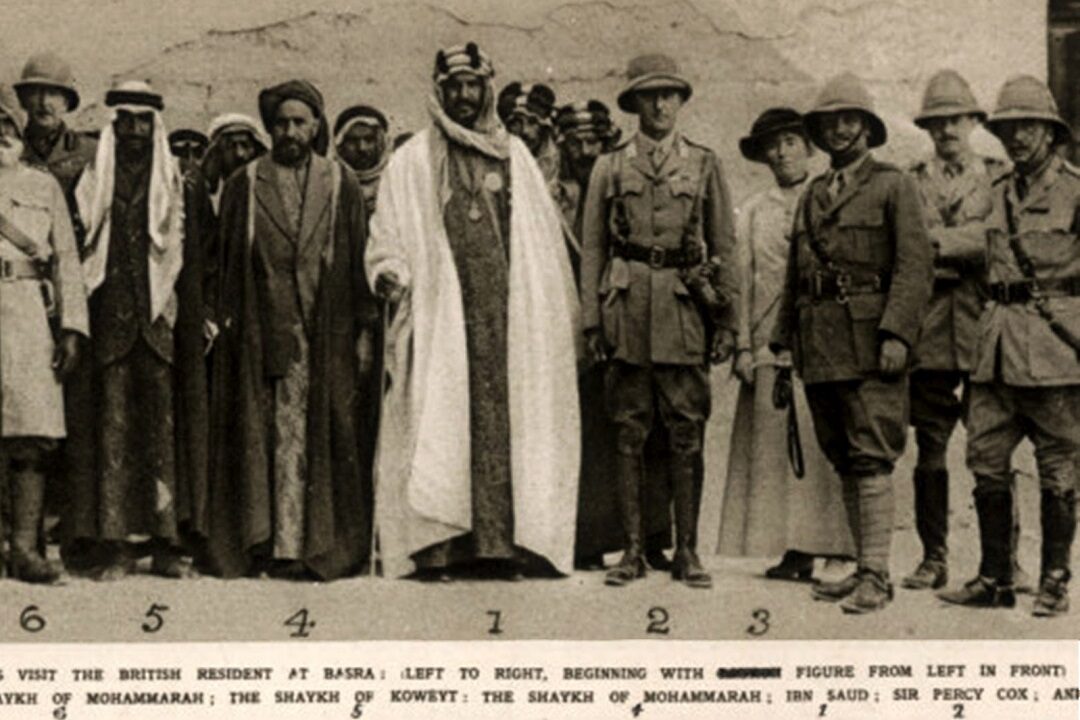
By Rez Karim,
Recognizing the contentious nature of the subject, this two-part article relies only on official treatises, pacts and primary sourced evidence to compile a historically accurate account of the founding of Saudi Arabia and Al Saud family becoming ‘Royals’.
Growing up Muslim in a Muslim majority country, I spent most Friday afternoons at a mosque, attending the Jummah prayer. First part of a Jummah prayer calls for the Imam to perform a Khutbah – a weekly sermon of sorts. It was in one of those Khutbahs that I, as a very young boy, learnt about the plight of the Palestinians for the first time.
Indeed, it’s a common practice among Imams around the world to bring up the Palestinian issue at mosques, especially during Friday sermons, and pray for the Palestinian people. In those prayers and discussions, Israel’s name comes up inevitably. In fact, Israel’s oppression of Palestinians bears no ambiguity in Islamic thoughts. And condemnation of Israel, therefore, comes naturally to Muslims around the world.
However, what escapes awareness in almost all Muslims is the connection between Israel and Saudi Arabia. While zealously castigating Israel for its atrocities, Muslims often revere Saudi Arabia as the custodians of Islam’s holiest sites; completely ignoring the Kingdom’s role in founding the Zionist state in the first place.
Notwithstanding the existence of a deep-seated bias against Israel among Muslims, it’s important to recognize that the lack of criticism for Saudi Kingdom, alongside Israel, doesn’t come from bias. Indeed, this absence finds its roots not in bias, but in a complete lack of knowledge. Knowledge among current generation of Muslims, as well as among the world population, about how Saudi Arabia and its founding king, Abdel Aziz Ibn Saud, played a critical role in establishing the Zionist state of Israel.
Suffice it to say, this ignorance about one of the most critical periods in world history seems anything but normal. Amazingly, the world, especially the Muslim world, had been kept in darkness about this momentous chapter in Middle East history. Propaganda and omissions run rampant within the historical accounts of this period. Official Saudi sources like House of Saud website, for example, avoids any mention of British involvement in founding the KSA. Although this omission seems predictable to many, it’s worth noting that even mainstream media outlets like the BBC, and prominent historians such as Professor Eugene Rogan etc., routinely portray Ibn Saud as having acted independently during WWI, and not as an instrument for the British Empire.
Therefore, recognizing the contentious nature of the issue – and to avoid becoming yet another ‘perspective’ on the subject – this article relies only on primary sourced evidence and the following four official treatises and declarations to compile a historically accurate account of the events:
- The McMahon-Hussain Correspondence
- The Treaty of Darin
- The Sykes-Picot Agreement
- The Balfour Declaration
1. The McMahon-Hussain Correspondence
To properly understand the events that led to the creation of both Israel and Saudi Arabia, we must travel back to the early 1900s’ Middle East. At the outbreak of WWI in the region, Sir Henry McMahon, then British High Commissioner in Egypt, offered Hussain bin Ali, Sharif of Hijaz (or ruler of the Hijaz – the western Arabian region in which Mecca and Medina lie), an independent Arab state if he would help the British fight against the Ottoman Empire. Hussein’s interest in throwing off his Turkish overlords converged with Britain’s war aim of defeating the Ottomans. McMahon made this offer via a series of letters exchanged between him and Sharif Hussain, collectively known as the McMahon-Hussain Correspondence. On his 14 July 1915 letter to McMahon, Hussain stated, among other things, the following as one of his propositions:
“Firstly.- England will acknowledge the independence of the Arab countries, bounded on the north by Mersina and Adana up to the 37th degree of latitude, on which degree fall Birijik, Urfa, Mardin, Midiat, Jezirat (Ibn ‘Umar), Amadia, up to the border of Persia; on the east by the borders of Persia up to the Gulf of Basra; on the south by the Indian Ocean, with the exception of the position of Aden to remain as it is; on the west by the Red Sea, the Mediterranean Sea up to Mersina. England to approve the proclamation of an Arab Khalifate of Islam.”
In response, McMahon wrote on 24 October 1915:
“I regret that you should have received from my last letter the impression that I regarded the question of the limits and boundaries with coldness and hesitation; such was not the case, but it appeared to me that the time had not yet come when that question could be discussed in a conclusive manner.
“I have realized, however, from your last letter that you regard this question as one of vital and urgent importance. I have, therefore, lost no time in informing the Government of Great Britain of the contents of your letter, and it is with great pleasure that I communicate to you on their behalf the following statement, which I am confident you will receive with satisfaction:-
“The two districts of Mersina and Alexandretta and portions of Syria lying to the west of the districts of Damascus, Homs, Hama and Aleppo cannot be said to be purely Arab, and should be excluded from the limits demanded.
“With the above modification, and without prejudice of our existing treaties with Arab chiefs, we accept those limits.”
Interestingly, throughout history, there has been much disagreement as to whether this promise included Palestine. However, as we can see above, the area promised to the Arabs in McMahon’s letter excluded only the territory to the west of a line from Damascus north to Aleppo. Palestine, far to the south, was, by implication, included. Nevertheless, the British subsequently denied that they included Palestine in the promise and refused to publish the correspondence until 1939.
At the time however, Sharif Hussain believed this official promise from the British Government. He went on to make the most significant contribution to the Ottoman Empire’s defeat. He switched allegiances and led the so-called ‘Arab Revolt’ in June of 1916, which removed the Turkish presence from Arabia.
The defeat of the Ottoman Empire by the British in WWI left three distinct authorities in the Arabian peninsula. Sharif of Hijaz Hussain bin Ali of Mecca (in the west); Ibn Rashid of Ha’il (in the north); and Emir Abdel Aziz Ibn Saud of Najd and his religiously fanatical followers, the Wahhabis (in the east).
2. The Treaty of Darin
On 26 December 1915, Sir Percy Cox, on behalf of the British Government, signed the Treaty of Darin with Abdel Aziz Ibn Saud. Also known as the Darn Pact, the treaty made the lands of the House of Saud a British protectorate. The British aim of the treaty was to guarantee the sovereignty of Kuwait, Qatar and the Trucial States (later UAE). Abdul-Aziz vowed not to attack these British protectorates. He also pledged to enter WWI in the Middle East against the Ottoman Empire as an ally of Britain.
Britain’s signing of Darin Pact in December went against their promises of mutual protection made to Sharif Hussain in October; because Britain’s treaty with Ibn Saud does not oblige him to not attack the Hijaz.
The treaty also saw Abdel Aziz receiving £5000 per month ‘tribute’ from the British Government. After World War I, he received further support from the British. Support included substantially more monetary rewards and a glut of surplus munitions.
3. The Sykes-Picot Agreement
On May 19, 1916, representatives of Great Britain and France secretly reached an accord, known as the Sykes-Picot Agreement. The accord aimed at dividing most of Arab lands under the Ottoman rule between the British and the French at the end of WWI. In its designated sphere, it was agreed, each country shall be allowed to establish such direct or indirect administration or control as they desire and as they may think fit.
Two diplomats, a Briton and a Frenchman, divided the map of one of the most volatile regions in the world into states that cut through ethnic and religious communities. The secret agreement largely neglected to allow for the future growth of Arab nationalism; which at that same moment the British government was using to their advantage against the Turks.
A century on, the Middle East continues to bear the consequences of the treaty. Many Arabs across the region continue to blame the subsequent violence in the Middle East, from the occupation of Palestine to the rise of the Islamic State of Iraq and the Levant (ISIL), on the Sykes-Picot treaty.
Indeed, Britain’s signing of this treaty went directly against what it promised to the Sharif of Hijaz in October of previous year. As we will see in Part II of this article, Britain’s betrayal of their promises of an independent Arab state eventually led them to unleash their attack dog, Ibn Saud, on Sharif Hussain and topple him. This allowed the British to effectuate the Sykes-Picot accord, and subsequently establish the Zionist state of Israel.
Abdel Aziz Ibn Saud’s actions during WWI eventually led to the founding of Saudi Arabia. To document a historically accurate account of his role, we examined in Part I three official documents from WWI. In Part II, we will examine one more war time declaration and narrate what really took place during that period.
4. The Balfour Declaration
One of the most important statements of British foreign policy of the twentieth century, the ‘Balfour Declaration’ was no more than a short, vague letter that had no legal status. The Parliament didn’t debate it. Yet, it was one of the most significant events leading ultimately to the creation of the state of Israel. Not to mention the conflict between Jews and Arabs ever since.
In this letter of November 2nd 1917, British Foreign Secretary, Arthur Balfour, wrote to Lord Lionel Walter Rothschild, as a figurehead of the Jewish community in Britain:
“His Majesty’s government view with favour the establishment in Palestine of a national home for the Jewish people, and will use their best endeavours to facilitate the achievement of this object, it being clearly understood that nothing shall be done which may prejudice the civil and religious rights of existing non-Jewish communities in Palestine, or the rights and political status enjoyed by Jews in any other country.”
Britain later incorporated this letter within the terms of it’s Mandate for Palestine. And so it became a legal requirement upon Britain.
To better understand the origins of the declaration, we examine a thoroughly documented paper by The Balfour Project. It documents critical details on why Britain’s War Cabinet at the time were so fervently predisposed to support the establishment of a ‘Jewish National Home’ in Arab inhabited Palestine.
With exhaustive references to literally dozens of books, news reports and Cabinet memorandums from The National Archives of the UK, the report paints a vivid picture of an ingenious manipulation behind the scenes – shaping the drafting, deliberations and the eventual adoption of this declaration. The unusual convergence of so many powerful and influential figures in British politics – including a current and a former Prime Ministers – in support of the Zionist cause isn’t lost on the authors. Detailed evidence suggest the entire British Empire, in its actions regarding the future of Palestine, behaved as a Zionist entity. In its analysis of the events, the paper states,
“It was widely believed that some mysterious but well-organised Jewish conspiracy was bent on determining the outcome of the war; their influence and, above all, their money, could sway Russia, the United States or Germany, to Britain’s good or ill. To gain the international favour of the Jews was therefore in Britain’s vital interest; to offend could be fatal. Since Weizmann implied that Zionism spoke for the Jews of the world, it followed that the Zionists should be helped. It was, [Prime Minister] Lloyd George wrote later, a question of making ‘a contract with Jewry’.”
It’s important to note that the British Cabinet, while adopting the Balfour Declaration, acted under the impression that majority of Jewish people worldwide were Zionists who would applaud Britain’s actions. However, in reality, Zionists remained a very small minority among Jews for many years to come.
For instance, in his book A Peace to End All Peace: Creating the Modern Middle East, 1914-1922 (Penguin, London, 1991), David Fromkin calculates that in 1913, the last date for which there were figures, only about one percent of the world’s Jews had signified their adherence to Zionism (p. 294). In other words, even though the official narrative claims that the Balfour Declaration was adopted to favour Jewish people worldwide, the underlying truth suggests it was rather the Zionists within the British Empire (which was pretty much everybody who was anybody in British government at the time) who orchestrated this declaration; using the Jewish people’s plight as an excuse to justify this unjust enterprise.
It’s also remarkable that the debates and deliberations which preceded adoption of this declaration, did not include any Arab representation; nor did they think it necessary to do so. While Britain accepted that Palestine should be reconstituted as the national home of the Jewish people, implying no place for the existing majority Arab population, very few Arabs were even aware that such a proposal was in the offing. And the Arabs in Palestine itself could not be consulted (then PM Lloyd George later argued) as they were in enemy territory, and were therefore deemed to be fighting against Britain.
Now, as we can see from reviewing the above four historical documents, British Empire, throughout their WWI campaign in the Middle East, played a cunning game of deception with the Arab people; making false promises with no intention of keeping them. A game all too common in empire-building, and certainly more so within the history of British imperialism. Nevertheless, as it always is the case, an empire cannot succeed in its treachery without a complicit, local cohort; a traitor from among the victims. And in this particular case, this cohort presented itself in the form of Abdel Aziz Ibn Saud.
To investigate Ibn Saud’s role, we examine a 2016 essay by independent researcher Nu’man Abd al-Wahid. Al-Wahid corroborates primary sourced evidence from a revealing study by Dr. Askar H. al-Enazy, titled The Creation of Saudi Arabia: Ibn Saud and British Imperial Policy, 1914-1927 (London: Routledge, 2010) with other prominent works in history such as The Birth of Saudi Arabia (London: Frank Cass, 1976) by Gary Troeller and The Desert King: The Life of Ibn Saud (London: Quartet Books, 1980) by David Howarth etc., and presents a comprehensive account of the part Abdel Aziz Ibn Saud played between 1915 to 1926 as a battering ram for the British Empire. In essence, Ibn Saud’s muscleman role was what enabled the British to establish their imperial and Zionist goals. Goals borne out of the Sykes-Picot Treaty and the Balfour Declaration.
As Dr. al-Enazy documents in his 2010 study, the Sharif of Hijaz, as soon as the war ended, wanted to hold the British to their wartime promises as expressed in the McMahon-Hussain correspondence. The British, on the other hand, wanted the Sharif to accept the Empire’s actual vision for Arabia. A vision that divides the Arab world between them and the French, and implements the Balfour Declaration.
However, the Sharif declared he will never sell out Palestine to the Empire’s Balfour Declaration. Nor will he accept new random borders drawn across Arabia by British and French imperialists.
After the Cairo Conference in March 1921, the Empire dispatched T.E. Lawrence (i.e. of Arabia) to meet the Sharif. Lawrence offered him an annual payment of £100,000 (al-Enazy 2010, p.111) but the Sharif refused to compromise. When financial bribery failed to persuade the Sharif, Lawrence threatened him with an Ibn Saud takeover.
While negotiating with Hussain, Lawrence also visited other leaders in the Arabian peninsula. He warned them against entering into an alliance with the Sharif. He informed, if they did, the Empire will unleash Ibn Saud and his Wahhabis on them. After all, Saud and his Wahhabis were at Britain’s “beck and call” (al-Enazy, p.111).
Simultaneously, after the Conference, the then Colonial Secretary Winston Churchill travelled to Jerusalem. There he met with the Sharif’s son, Abdullah, who the British appointed the Emir of a new territory called Transjordan. Churchill asked him to persuade “his father to accept the Palestine mandate and sign a treaty to such effect,”; if not “the British would unleash Ibn Saud against Hijaz” (al-Enazy p.107).
Meanwhile, the British devised plans to take down ibn Rashid of Ha’il in the North. Ibn Rashid had rejected all propositions from the British Empire. Propositios made to him via Ibn Saud to become another one of Empire’s puppets (al-Enazy p.45-46, p.101-102). Instead, Rashid expanded his territories north to the newly mandated Palestinian border. He also widened his territories to the borders of Iraq in the summer of 1920. Acting under a concern that Ibn Rashid may seek an alliance with Sharif Hussain, Churchill agreed with imperial officer Sir Percy Cox at the Cairo Conference that “Ibn Saud should be given the opportunity to occupy Hail” (al-Enazy p.104).
By the end of 1920, the British were showering Ibn Saud with “a monthly ‘grant’ of £10,000 in gold; on top of his monthly subsidy. He also received abundant arms and supplies, totalling more than 10,000 rifles, in addition to the critical siege and four field guns” with British-Indian instructors (al-Enazy p.104). Finally, in September 1921, the British unleashed Ibn Saud on Ha’il which officially surrendered in November 1921. It was after this victory the British bestowed a new title on Ibn Saud. He was no longer the “Emir of Najd and Chief of its Tribes” but “Sultan of Najd and its Dependencies”. Ha’il had dissolved into a dependency of the Empire’s Sultan of Najd.
With Ibn Saud now on Sharif Hussain’s border, and armed to the teeth by the British, the Empire arranged a new round of talks with Sharif’s son Abdullah; and drafted a treaty accepting Zionism. When it was delivered to the Sharif with an accompanying letter from his son requesting that he “accept reality”, Sharif didn’t even bother to read the treaty and instead composed a draft treaty himself rejecting the new divisions of Arabia, as well as the Balfour Declaration, and sent it to London to be ratified (al-Enazy p.113).
After another three rounds of negotiations in Amman and London, the Empire realized Hussain will never relinquish Palestine to Great Britain’s Zionist project or accept the new divisions in Arab lands (al-Enazy p.112-125).
In March 1924, the British announced that they had terminated all discussions with Sharif Hussain (al-Enazy p.129). Within weeks, the forces of Ibn Saud and his Wahhabi followers began to administer what the British foreign secretary Lord Curzon called “the final kick” to Sharif Hussain and attacked Hijazi territory (al-Enazy p.106). By September 1924, Ibn Saud had overrun the summer capital of Sharif Hussain, Ta’if.
Ibn Saud captured the holiest place in Islam, Mecca, in mid-October 1924. Sharif Hussain abdicated and went on exile to the Hijazi port of Akaba. His son Ali replaced him as the monarch and made Jeddah his governmental base. Fearing that Sharif Hussain may use Akaba as a base to rally Arabs against the Empire’s own Ibn Saud, the British declared that Hussain must leave Akaba or Ibn Saud will attack the port. In response, Hussain countered that he had,
“never acknowledged the mandates on Arab countries and still protest against the British Government which has made Palestine a national home for the Jews.” (al-Enazy p.119)
He was subsequently forced out of Akaba, a port Hussain himself liberated from the Ottoman Empire during the ‘Arab Revolt’. On 18th June 1925, Hussain left Akaba on HMS Cornflower.
Ibn Saud began his siege of Jeddah in January 1925. The city finally surrendered in December 1925. This brought an end to over 1000 years of rule by the Prophet Muhammad’s descendants. The British officially recognized Ibn Saud as the new King of Hijaz in February 1926. Other European powers followed suit within weeks. The British Empire rebranded the new unified Wahhabi state in 1932 as the “Kingdom of Saudi Arabia” (KSA). A certain George Rendel, an officer working at the Middle East desk at the Foreign Office in London, claimed credit for the new name.
In conclusion, any prudent observer of British Imperialism hardly finds it surprising that the British Empire betrayed their promises made to the Arabs for an independent Arab state after WWI. However, when an Arab leader does the betraying and becomes an agent for the British Empire; when this agent massacres Arabs who dare oppose the Zionist deceit; and finally, when he gets appointed ‘King of Arabia’ as a reward for his treachery – by the same treacherous Empire who deceived the Arab people; when an Arab Emir does this, he becomes a traitor. And he remains a traitor for eternity; because no amount of wealth or propaganda can change the plain truth: that Abdel Aziz Ibn Saud became the King of Arabia – and his Al Saud family ‘Royals’ – because he betrayed Arabs and became an agent of the British Empire; and henceforth executed the Empire’s Zionist plans for the Arabian peninsula.
Indeed, the bitter irony isn’t lost on Muslims in the know. That the two holiest sites in Islam are today governed by the Saudi clan and Wahhabi teachings because they helped the British Empire lay foundations for Zionism in Arabia during and after World War One.
Source: https://vitalcolumns.com
Disclaimer: We at Prepare for Change (PFC) bring you information that is not offered by the mainstream news, and therefore may seem controversial. The opinions, views, statements, and/or information we present are not necessarily promoted, endorsed, espoused, or agreed to by Prepare for Change, its leadership Council, members, those who work with PFC, or those who read its content. However, they are hopefully provocative. Please use discernment! Use logical thinking, your own intuition and your own connection with Source, Spirit and Natural Laws to help you determine what is true and what is not. By sharing information and seeding dialogue, it is our goal to raise consciousness and awareness of higher truths to free us from enslavement of the matrix in this material realm.
 EN
EN FR
FR


























This is just another part of our history that has been kept from us – They have lied about everything including history to cover up their horrors. We must go forward in truth – no more lies.
If we recall the Protocols of Zion, which I believe is the Reptilian Plan, we remember that it is said of the world tyranny they intended to create, “When everything they (meaning us) is a lie, then we will spring our trap.” Then the internet came along and leaks and eventually information blowouts occurred. Since they couldn’t seem to get rid of Trump, who was/is apparently an imminent danger to them, and because we wiggled out of some of their previous plans, they had to make their move suddenly, but with long planned fake pandemics, riots, and chaos from which to raise a New World Order. (I believe the emphasis on racism in these riots shows it’s an old plan that was originally meant to be implemented decades ago.) Now as more and more of our history becomes apparent, we see that they lied about everything. No war was ever fought for the reasons they fed the common folk they needed to fight the wars for them. We know nothing of very ancient history predating the human rise after whatever cataclysms occurred 12,500 years ago. But people are slowly putting the pieces together. It leads off planet, which is what our reptile friends don’t want. They want us to think we’re just cavemen hardly out of the caves and certainly there’s no interdimensional entities harvesting our planet. So that’s the real reason we don’t know our history. It’s been very well hidden, even as it was being made.
These events become More Important to Study then Israel, due to these events were indeed First. First to Kick Off World War One & Forever change The Demographics Everywhere, for the Worse. So Please invest time to read.
His story: The single energy male can only create situations of absolute control of others because they give their power to other males and fear being found inadequate as a male.